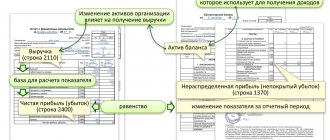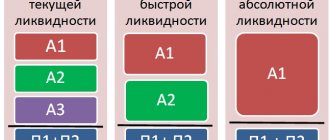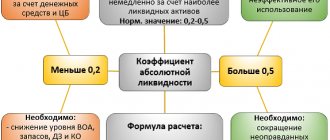General concept of net assets
Assessing the performance efficiency and successfully planning the work of modern companies is impossible without analyzing their economic indicators.
One of the most important values among such indicators is the value of net assets (NA). The value of net assets is the difference between the value of all the organization’s assets (property, land, cash, etc.) and the sum of all its liabilities (debts for taxes and payments to the budget, loans, etc.). To put it simply, net assets are those company funds that will remain after repaying debts to creditors.
The calculation of net assets is mandatory once a year and is reflected in the annual financial statements on line 3600 of Section 3 of the Statement of Changes in Capital. It is also done when necessary to obtain information about the current financial situation, to pay interim dividends or the actual value of the share to the participant.
What is the minimum acceptable value of the net assets of an LLC was explained by ConsultantPlus experts. If you do not have access to the K+ system, get a trial online access for free.
What is the accounting value of net assets
The term “accounting value” (or “accounting unit”) is used as a certain parameter, which is one of the accounting characteristics of an economic object or process. For example, the key rate is the accounting value of the interest rate of the Central Bank of the Russian Federation.
In turn, the accounting value of net assets is, if you follow the general definition of their essence, the value of the organization’s property, reduced by the amount of debts and expressed in rubles or foreign currency, sometimes in an alternative monetary unit (for example, in bitcoins). However, in official accounting, as a rule, assets in generally recognized fiat currency are taken into account.
There are several approaches to calculating the value of net assets . The most popular among Russian experts are:
- an approach according to which the value of net assets is defined as identical to the size of the company’s equity capital;
- an approach according to which the value of net assets is determined as the difference between the total value of the organization's assets and liabilities.
Let's study their specifics in more detail.
How to calculate net asset value according to the 2022 balance sheet (formula)
To find out this, let us turn to the order of the Ministry of Finance of Russia dated August 28, 2014 No. 84n, which provides the procedure for calculating net assets.
It is valid for companies of the following forms of ownership:
- joint stock companies (public and non-public);
- limited liability companies;
- state and municipal unitary enterprises;
- cooperatives (industrial and housing savings);
- business partnerships.
According to Order No. 84n, to calculate the company’s net assets, the value of liabilities must be subtracted from the value of assets. The formula used for this is:
NA = (VAO + OJSC – ZU – ZVA) – (DO + KO – DBP),
Where:
NA - net assets;
VAO - non-current assets of the organization;
OJSC - current assets of the organization;
ZU - the debt of the founders to the organization to fill shares in the authorized capital;
ZBA - debt incurred during the repurchase of own shares;
DO - long-term obligations;
KO - liabilities of a short-term nature;
DBP - future income (in the form of government assistance and gratuitous receipt of property).
To calculate net assets, you can also use the data contained in the company's balance sheet. To calculate the value of net assets on the balance sheet, the formula can be modified:
NA = (line 1600 – ZU) – (line 1400 + line 1500 – DBP).
EXAMPLE from ConsultantPlus: The authorized capital is paid in full. There were no gratuitous receipts or state aid. Balance sheet indicators as of March 31: asset (line 1600) - RUB 1,400,000; long-term liabilities (line 1400) - 800,000 rubles.... Get trial demo access to the K+ system and proceed to the calculation example for free.
For more information about the values given in this formula, read the article “Net assets - what is it in the balance sheet (nuances)?” .
Please note that it is not enough to simply do the calculation on a calculator; it must also be formalized. And there is no approved form. Companies must develop a form for calculating net assets for 2022 independently and approve it as an annex to their accounting policies. However, earlier, before the publication of Order No. 84n of the Ministry of Finance dated August 28, 2014, the form given in the appendix to Order No. 10 of the Ministry of Finance of the Russian Federation and the Federal Commission for the Securities Market of Russia dated January 29, 2003 No. 03-6/pz was used to calculate net assets. The form of this form lists all the indicators that are required to calculate net assets even now, therefore we consider its use acceptable (after its approval in the accounting policies of the organization).
You can download this form on our website:
Which method of calculating the NA to choose
First of all, it is worth paying attention to the fact that the first of the methods we examined, in principle, can hardly be called the most popular among economists. It is used only due to the permissible identity of the concepts “equity capital” and “net assets” - based on certain provisions of economic theory, as well as the norms of the legislation of the Russian Federation. The fact is that most experts are still inclined to consider net assets as an indicator that involves deducting the company's liabilities.
The approach that uses indicators on lines 1310-1370 will actually be valid only in one scenario: the company has no liabilities that could be deducted from equity. This state of affairs is possible, for example, if the individual entrepreneur works for himself, has no loans and does not hire employees.
In this case, it is legitimate to talk about one-sided identity, when any net assets should be considered as equity capital, but not all equity capital should be considered as net assets.
Read more about the correlation between the concepts of “net assets” and “equity capital” in the article “What is included in the equity capital of an enterprise (formula)?”
Thus, in general, the financier will use the 2nd method. Let's call it the Ministry of Finance method.
But if, for example, a company, due to the ideality of its business model, does not have short-term and long-term obligations, the debts of the founders for contributions to the authorized capital have been paid, and deferred income is not recorded in accounting, it is quite possible to get by with a simpler formula for determining the value of net assets, and names: based on the total indicators on lines from 1310 to 1370 of the balance sheet.
Net Asset Value Analysis
It is easy to conclude that when analyzing net assets, the output should be positive. A negative one will indicate that the company is unprofitable and with a high degree of probability in the near future may become completely insolvent, that is, insolvent. The only exception can be a recently opened company, since during its existence the invested funds did not have time to justify themselves and did not generate income for objective reasons. Thus, the dynamics of calculating net assets is one of the key indicators of the company’s financial condition.
Note that when calculating and assessing net assets, the authorized capital of the company plays an important role. If the amount of net assets exceeds the amount of the authorized capital, this indicates the well-being of the company. If the net assets at some stage become less than the amount of the authorized capital, this indicates the opposite: the organization is operating at a loss.
What consequences await the company if net assets are less than the authorized capital, read here.
Let us repeat: this situation is acceptable only for the 1st year of the company’s operation. However, if after this period the situation does not change in a positive direction, the company’s management is obliged to reduce the size of the authorized capital to the amount of net assets. If this figure is equal to or less than the minimum indicators established by law, the issue of closing the enterprise should be raised (clause 4, article 30 of the Law “On LLC” dated 02/08/1998 No. 14-FZ).
Find out what ways to increase net assets and avoid closing a company from the Ready-made solution from ConsultantPlus by getting trial access to the system.
Read more about the consequences of negative NAV values in the material “What are the consequences of negative net assets?” .
In what cases should net assets be calculated?
Firstly, it is necessary to identify net assets in order to keep the organization afloat and prevent its forced liquidation as required by the Civil Code of the Russian Federation. The point is that if a company for 2 financial years in a row has private equity, which in terms of value is less than the authorized capital (hereinafter referred to as the authorized capital) of such an organization, then its financial situation is considered critical. The situation must be corrected immediately, otherwise the company will have to be liquidated (Clause 4, Article 90 of the Civil Code of the Russian Federation).
Important! This shortcoming can be corrected in two ways: either reduce the amount of equity capital, leveling it with assets, or directly increase net assets.
Consequently, in the practice of any company, calculating net assets is an urgent task that has to be solved regularly, albeit with different frequency. In order to prevent a crisis state of the company’s asset structure, when it is necessary to take emergency measures, changes in the company’s NAV should be timely monitored.
Secondly, several circumstances, upon the occurrence of which the company is also obliged to calculate the value of net assets, are spelled out in the Law “On LLC” dated 02/08/1998 No. 14-FZ. In particular, this procedure is carried out if any LLC participant decides to leave the company’s owners. As a general rule, such a participant must be returned the value of his share in the organization in monetary terms (Clause 2, Article 23 of Law No. 14-FZ). The specified value of the share should be calculated based on the value of the company's NA in proportion to the share (as a percentage) of the participation of such owner in the company's business.
ConsultantPlus experts explained in detail what is the minimum acceptable value of the net assets of an LLC. Get trial demo access to the system and upgrade to the Ready Solution for free.
The second such circumstance is the situation when the owners decide to increase the company’s capital at the expense of the company’s funds. In this case, there is a limitation: if the amount by which the owners want to increase the capital is less than the value of current net assets minus the authorized and reserve capital, then the increase in the capital will not be allowed in accordance with clause 2 of Art. 18 of Law No. 14-FZ.
Thirdly, there is another typical situation when an organization needs to calculate the cost of its NA. It is typical for both JSC and LLC: it is the payment of dividends to participants. Due to the provisions of the law, an organization in the form of an LLC cannot pay dividends if its net assets are below the value of the authorized capital (clauses 1, 2 of Article 29 of Law No. 14-FZ). For a JSC, the situation is almost the same: dividends cannot be paid if the value of the private equity capital is less than the sum of the authorized and reserve capital (clause 4 of Article 43 of the Law “On JSC” dated December 26, 1995 No. 208-FZ).
Please pay attention! In addition to the above situations, others are possible when a company has to calculate this indicator, for example, at the request of a potential investor. At the same time, it is important to make the calculation as accurate and transparent as possible, and therefore document it.
Thus, in the daily practice of any company, there is a high probability of the need to calculate the value of the company’s NA. But how to calculate net assets correctly, without forgetting anything?
Results
The amount of net assets is one of the most important indicators of the financial viability of an organization. The higher it is, the more successful the organization and the more attractive it is for investment. Only an organization with high net assets can guarantee the interests of its creditors. This is why it is necessary to be very careful when assessing the value of a company's net assets.
Sources:
- Order of the Ministry of Finance of Russia dated August 28, 2014 No. 84n
- Federal Law of 02/08/1998 No. 14-FZ “On Limited Liability Companies”
You can find more complete information on the topic in ConsultantPlus. Free trial access to the system for 2 days.
Calculation of the accounting value of NAV: assets as equity capital
The identification of net assets and equity capital of a company is a tradition that has been consolidated not only among economists, but also at the level of some legal acts issued in the Russian Federation. For example, in the provisions of paragraph 3 of Art. 35 of the Federal Law “On Joint-Stock Companies” dated December 26, 1995 No. 208-FZ states that in credit structures, instead of the value of net assets, it is precisely the equity capital indicator that is calculated.
In turn, economists traditionally include the following components in equity capital:
- authorized, additional and reserve capital of the company;
- its retained earnings;
- the amount of increase in the value of non-current assets after revaluation;
- the cost of shares purchased by the company from the owners.
In order to calculate the SC, it is necessary to add up the numbers reflecting the indicators noted above. It is quite simple for a Russian financier to do this: the terms will be indicators that generally correspond to lines from 1310 to 1370 of the balance sheet, the form of which was approved by order of the Ministry of Finance of Russia dated July 2, 2010 No. 66n.
Thus, the accounting value of net assets (NA) within the framework of the approach in question is determined by the formula:
NA = Page 1310 + Page 1320 + Page 1340 + Page 1350 + Page 1360 + Page 1370.
Let's study another popular and at the same time somewhat more complex approach to calculating the value of net assets.








